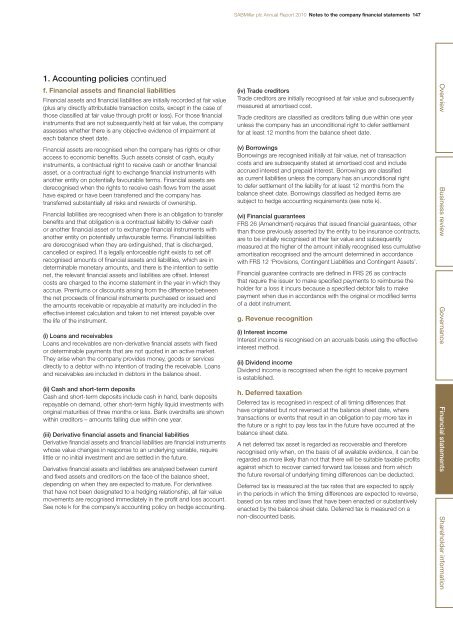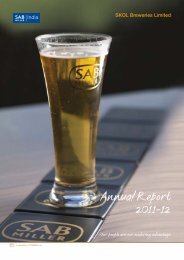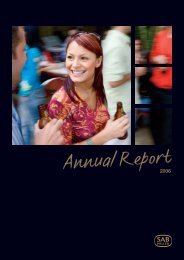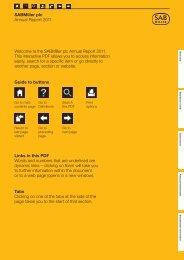Annual Report - SABMiller
Annual Report - SABMiller
Annual Report - SABMiller
- No tags were found...
Create successful ePaper yourself
Turn your PDF publications into a flip-book with our unique Google optimized e-Paper software.
<strong>SABMiller</strong> plc <strong>Annual</strong> <strong>Report</strong> 2010 Notes to the company financial statements 1471. Accounting policies continuedf. Financial assets and financial liabilitiesFinancial assets and financial liabilities are initially recorded at fair value(plus any directly attributable transaction costs, except in the case ofthose classified at fair value through profit or loss). For those financialinstruments that are not subsequently held at fair value, the companyassesses whether there is any objective evidence of impairment ateach balance sheet date.Financial assets are recognised when the company has rights or otheraccess to economic benefits. Such assets consist of cash, equityinstruments, a contractual right to receive cash or another financialasset, or a contractual right to exchange financial instruments withanother entity on potentially favourable terms. Financial assets arederecognised when the rights to receive cash flows from the assethave expired or have been transferred and the company hastransferred substantially all risks and rewards of ownership.Financial liabilities are recognised when there is an obligation to transferbenefits and that obligation is a contractual liability to deliver cashor another financial asset or to exchange financial instruments withanother entity on potentially unfavourable terms. Financial liabilitiesare derecognised when they are extinguished, that is discharged,cancelled or expired. If a legally enforceable right exists to set offrecognised amounts of financial assets and liabilities, which are indeterminable monetary amounts, and there is the intention to settlenet, the relevant financial assets and liabilities are offset. Interestcosts are charged to the income statement in the year in which theyaccrue. Premiums or discounts arising from the difference betweenthe net proceeds of financial instruments purchased or issued andthe amounts receivable or repayable at maturity are included in theeffective interest calculation and taken to net interest payable overthe life of the instrument.(i) Loans and receivablesLoans and receivables are non-derivative financial assets with fixedor determinable payments that are not quoted in an active market.They arise when the company provides money, goods or servicesdirectly to a debtor with no intention of trading the receivable. Loansand receivables are included in debtors in the balance sheet.(ii) Cash and short-term depositsCash and short-term deposits include cash in hand, bank depositsrepayable on demand, other short-term highly liquid investments withoriginal maturities of three months or less. Bank overdrafts are shownwithin creditors – amounts falling due within one year.(iii) Derivative financial assets and financial liabilitiesDerivative financial assets and financial liabilities are financial instrumentswhose value changes in response to an underlying variable, requirelittle or no initial investment and are settled in the future.Derivative financial assets and liabilities are analysed between currentand fixed assets and creditors on the face of the balance sheet,depending on when they are expected to mature. For derivativesthat have not been designated to a hedging relationship, all fair valuemovements are recognised immediately in the profit and loss account.See note k for the company’s accounting policy on hedge accounting.(iv) Trade creditorsTrade creditors are initially recognised at fair value and subsequentlymeasured at amortised cost.Trade creditors are classified as creditors falling due within one yearunless the company has an unconditional right to defer settlementfor at least 12 months from the balance sheet date.(v) BorrowingsBorrowings are recognised initially at fair value, net of transactioncosts and are subsequently stated at amortised cost and includeaccrued interest and prepaid interest. Borrowings are classifiedas current liabilities unless the company has an unconditional rightto defer settlement of the liability for at least 12 months from thebalance sheet date. Borrowings classified as hedged items aresubject to hedge accounting requirements (see note k).(vi) Financial guaranteesFRS 26 (Amendment) requires that issued financial guarantees, otherthan those previously asserted by the entity to be insurance contracts,are to be initially recognised at their fair value and subsequentlymeasured at the higher of the amount initially recognised less cumulativeamortisation recognised and the amount determined in accordancewith FRS 12 ‘Provisions, Contingent Liabilities and Contingent Assets’.Financial guarantee contracts are defined in FRS 26 as contractsthat require the issuer to make specified payments to reimburse theholder for a loss it incurs because a specified debtor fails to makepayment when due in accordance with the original or modified termsof a debt instrument.g. Revenue recognition(i) Interest incomeInterest income is recognised on an accruals basis using the effectiveinterest method.(ii) Dividend incomeDividend income is recognised when the right to receive paymentis established.h. Deferred taxationDeferred tax is recognised in respect of all timing differences thathave originated but not reversed at the balance sheet date, wheretransactions or events that result in an obligation to pay more tax inthe future or a right to pay less tax in the future have occurred at thebalance sheet date.A net deferred tax asset is regarded as recoverable and thereforerecognised only when, on the basis of all available evidence, it can beregarded as more likely than not that there will be suitable taxable profitsagainst which to recover carried forward tax losses and from whichthe future reversal of underlying timing differences can be deducted.Deferred tax is measured at the tax rates that are expected to applyin the periods in which the timing differences are expected to reverse,based on tax rates and laws that have been enacted or substantivelyenacted by the balance sheet date. Deferred tax is measured on anon-discounted basis.Overview Business review Governance Financial statements Shareholder information













